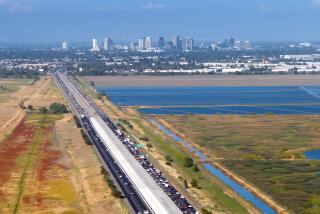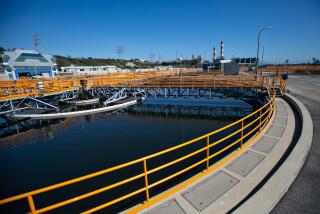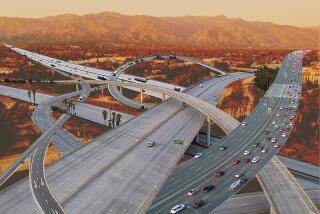Commentary : User Fees: Key to Freeway Woes
As I understand the debate over Orange County’s proposed new freeway corridors, I have two choices:
- Oppose the new freeways, in which case the South County will still grow and freeway congestion will become intolerable.
- Build the freeways, in which case the South County will grow even faster and congestion will become intolerable.
Faced with this pair of choices, I want to vote “none of the above.”
People on both sides agree that none of the new freeways will reduce congestion to acceptable levels. As they argue over degrees of agony in an unhappy world, they drag us unwillingly into a new era of helplessness quite at odds with Orange County’s traditional self-confidence. Must we accept, then, that our region is doomed by its own natural amenities to grow toward an overcrowded, over-congested future? No. There is a third choice--user charges--that can change the terms of debate. This choice is not just a professor’s dream: Like underwear, it can be imported from Hong Kong or Singapore.
To see why new highways alone cannot solve the problem, we need to understand why the demand for them seems so insatiable. The reason is that their services are provided virtually for free. True, we pay for highways in general, through gasoline taxes and license fees. But we do not pay specifically for what really counts: the right to use the Santa Ana Freeway during afternoon rush hour. Nothing in the current system of taxes and fees motivates me to reduce my use of congested highways at critical times. Yet it just that type of use that forces agonizing decisions over new freeways, with all their costs.
Many goods that play an important role in our economy would be subject to the same unresolvable dilemma if provided free. Air travel, telephone calls, and beachfront houses are just a few examples. Demand for these goods is kept in bound by their price, and we seldom have a supply crisis over them. Demand for highway use at rush hour could similarly be kept in bound--if it were priced.
The deterrent effect of congestion itself is obviously not sufficient. Congestion deters further traffic only when it has become inefficiently and irritatingly severe. No foreseeable amount of new highway construction will change this fact. Only pricing can reduce congestion without generating new traffic. What is needed is an explicit charge for use of highly congested roads.
Developer fees along the new corridors are an attempt to do this, but they are too crude. They do not charge anyone for using any freeway during afternoon rush hour. It’s a bit like forcing developers to subsidize all long-distance phone calls routed through the county. It may raise money, but it’s no way to ration expensive telephone lines.
How could such a charge be administered? Several methods, far more sophisticated than old-fashioned toll booths, are available. Some were studied by a British commission more than 20 years ago. Others have been tested in real urban traffic environments in Singapore and Hong Kong.
We should not be deterred by allegations of harm to people who “must” drive during rush hour. The more we learn about travel decisions, the more flexibility we discover. Hardly anyone lacks at least some control over the exact hours of travel, use of car pooling or public transit, choice of route, or discretionary trips. Over a longer time-horizon we also exert control over where we work and live. Developers in turn exert control over where offices, factories and homes are built. It is clear that those decisions are greatly influenced by the quality of highway access. Why should we doubt that they could be equally influenced by the system of user charges in effect on those highways?
The favorable experience with traffic during Los Angeles’ Olympic Games is testimony to the flexibility of travel decisions. We are left with the knowledge, verified time and again, that urban highways reach equilibrium only at levels of congestion that, at least for a few hours each day, exceed everyone’s notion of propriety.
What would actually happen if we instituted user charges on highly congested freeways? Probably the most noticeable effect would be more car pooling and van pooling. Pricing affects this in a fundamentally different way from congestion itself. In the absence of diamond lanes, congestion alone, no matter how severe, offers little incentive to car pool: drivers and passengers are equally delayed. A congestion charge levied on a per-vehicle basis, in contrast, contains an automatic group discount.
Finally, what about the new freeway corridors? How much growth and how many new highways should Orange County allow? This is a political decision that should depend on the kind of urban development we want, not on how much congestion we have. We could allow new growth and build highways to accommodate it, or we could restrict growth and leave the freeway system essentially what it is.
Either way, we need not tolerate the congestion that is now commonplace. We will be better off paying more for rush-hour trips, and getting the quality of service on those trips that is appropriate to a well-functioning metropolitan economy. Orange County deserves freeways that work, not more freeways than don’t.
More to Read
Sign up for Essential California
The most important California stories and recommendations in your inbox every morning.
You may occasionally receive promotional content from the Los Angeles Times.










